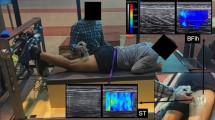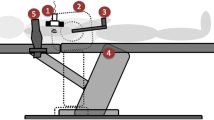Abstract
Purpose
Recent advancements in elastography techniques, specifically supersonic shearwave elastography (SWE), have enabled non-invasive assessment of muscle stiffness. However, there is limited research on the immediate and short-term effects of eccentric exercise-induced muscle damage (EIMD) in well-trained individuals. This study aimed to follow up on the effects of eccentric training on the biceps brachialis stiffness by supersonic shearwave imaging (SSI) as well as the soreness and elbow flexion maximal voluntary isometric contraction (MVIC), immediately post-intervention, at 10 min, 48 h, and 96 h in well-trained men.
Methods
Thirteen well-trained males participated in the study. Baseline measurements of elastography images, MVIC of the elbow flexors, and muscle soreness were obtained. The participants performed an eccentric exercise protocol (4 sets X 10 repetitions) on the dynamometer isokinetic and elastography measurements were repeated immediately post-exercise, at 10 min, 48 h, and 96 h.
Results
Significant reductions in stiffness (measured by shear modulus (µ)) were observed immediately and at 10 min post-exercise. MVIC exhibited significant reductions immediately after, 10 min, and 48 h compared to baseline measurements. Muscle soreness peaked at 48 h, persisting until 96 h.
Conclusions
The BB stiffness and MVIC reduction immediately post-eccentric exercise in well-trained men, suggest the potential involvement of mechanical stress and sarcomere rupture. Trained individuals may exhibit a distinct response to EIMD compared to untrained individuals, highlighting the applicability of elastography in monitoring acute biomechanical changes following high-intensity exercise.




Similar content being viewed by others
Data and materials availability
The data that support the findings of this study are available from the corresponding author upon reasonable request.
References
Withee ED, Tippens KM, Dehen R, Tibbitts D, Hanes D, Zwickey H (2017) Effects of Methylsulfonylmethane (MSM) on exercise-induced oxidative stress, muscle damage, and pain following a half-marathon: A double-blind, randomized, placebo-controlled trial. J Int Soc Sports Nutr 14(1):1–11. https://doi.org/10.1186/s12970-017-0181-z
Matta TTD, Pereira WCDA, Radaelli R, Pinto RS, Oliveira LFD (2018) Texture analysis of ultrasound images is a sensitive method to follow-up muscle damage induced by eccentric exercise. Clin Physiol Funct Imaging 38(3):477–482. https://doi.org/10.1111/cpf.12441
Peake JM, Suzuki K, Wilson G, Hordern M, Nosaka K, MacKinnon L et al (2005) Exercise-induced muscle damage, plasma cytokines, and markers of neutrophil activation. Med Sci Sports Exerc 37(5):737–745. https://doi.org/10.1249/01.mss.0000161804.05399.3b
Hyldahl RD, Hubal MJ (2014) Lengthening our perspective: Morphological, cellular, and molecular responses to eccentric exercise. Muscle Nerve 49(2):155–170. https://doi.org/10.1002/mus.24077
Lieber RL, Fridén J (1999) Mechanisms of muscle injury after eccentric contraction. J Sci Med Sport 2(3):253–265. https://doi.org/10.1016/s1440-2440(99)80177-7
Clarkson PM, Sayers SP (1999) Etiology of exercise-induced muscle damage. Can J Appl Physiol 24(3):234–248. https://doi.org/10.1139/h99-020
Matta TT, Pinto RO, Leitão BFM, de Oliveira LF (2019) Non-uniformity of elbow flexors damage induced by an eccentric protocol in untrained men. J Sport Sci Med 18(2):233
Ličen U, Kozinc Ž (2022) Using shear-wave elastography to assess exercise-induced muscle damage: a review. Sensors (Basel) 22(19):7574. https://doi.org/10.3390/s22197574
Lima KMM, Costa Jr JFS, Pereira de WCA, De Oliveira LF. (2018) Assessment of the mechanical properties of the muscle-tendon unit by supersonic shear wave imaging elastography: a review. Ultrasonography 37(1):3–15. https://doi.org/10.14366/usg.17017
Miller T, Bello UM, Tsang CSL, Winser SJ, Ying MTC, Pang MYC (2023) Using ultrasound elastography to assess non-invasive, non-pharmacological interventions for musculoskeletal stiffness: a systematic review and meta-analysis. Disabil Rehabil 5:1–15. https://doi.org/10.1080/09638288.2023.2252744
Shiina T (2013) JSUM ultrasound elastography practice guidelines: basics and terminology. J Med Ultrason 40(4):309–323. https://doi.org/10.1007/s10396-013-0490-z
Gennisson JL, Deffieux T, Fink M, Tanter M (2013) Ultrasound elastography: principles and techniques. Diagn Interv Imaging 94(5):487–495. https://doi.org/10.1016/j.diii.2013.01.022
Lacourpaille L, Nordez A, Hug F, Couturier A, Dibie C, Guilhem G (2014) Time-course effect of exercise-induced muscle damage on localized muscle mechanical properties assessed using elastography. Acta Physiol 211(1):135–146. https://doi.org/10.1111/apha.12272
Lacourpaille L, Nordez A, Hug F, Doguet V, Andrade R, Guilhem G (2017) Early detection of exercise-induced muscle damage using elastography. Eur J Appl Physiol 117(10):2047–2056. https://doi.org/10.1007/s00421-017-3695-9
Xu J, Fu SN, Zhou D, Huang C, Hug F (2019) Relationship between pre-exercise muscle stiffness and muscle damage induced by eccentric exercise. Eur J Sport Sci [Internet] 19(4):508–516. https://doi.org/10.1080/17461391.2018.1535625
Newton MJ, Morgan GT, Chapman DW, Nosaka KK (2008) Trained and untrained men. J Strength Cond Res 22(2):597–607. https://doi.org/10.1519/JSC.0b013e3181660003
Meneghel A, Verlengia R, Criso AH, Aoki MS, Nosaka K, Mota GR, Lopes CR (2014) Muscle damage of resistance-trained men after two bouts of eccentric bench press exercise. J Strength Cond Res 28(10):2961–2966. https://doi.org/10.1519/JSC.0000000000000494
Ferreira DV, Ferreira-Ju´nior, JB, Soares, SRS, Cadore, EL, Izquierdo, M, Brown, LE, and Bottaro, M. (2017) Chest press exercises with different stability requirements result in similar muscle dam- age recovery in resistance trained men. J Strength Cond Res 31(1):71–79. https://doi.org/10.1519/JSC.0000000000001453
Matta TT, de Salles BF, Spinetti J, Simão R, Oliveira LF (2010) Specific tension index of elbow flexors in trained and untrained men. Rev Bras Cineantropometria e Desempenho Hum 12(1):62–67
Suchomel TJ, Nimphius S, Bellon CR, Stone MH (2018) The importance of muscular strength: training considerations. Sport Med [Internet] 48(4):765–785. https://doi.org/10.1007/s40279-018-0862-z
Chen HL, Nosaka K, Chen TC (2012) Muscle damage protection by low-intensity eccentric contractions remains for 2 weeks but not 3 weeks. Eur J Appl Physiol 112(2):555–565. https://doi.org/10.1007/s00421-011-1999-8
Chan R, Newton M, Nosaka K (2012) Effects of set-repetition configuration in eccentric exercise on muscle damage and the repeated bout effect. Eur J Appl Physiol 112(7):2653–2661. https://doi.org/10.1007/s00421-011-2247-y
Koo TK, Li MY (2016) A guideline of selecting and reporting intraclass correlation coefficients for reliability research. J Chiropr Med 15(2):155–163. https://doi.org/10.1016/j.jcm.2016.02.012
Paulsen G, Mikkelsen UR, Raastad T, Peake JM (2012) Leucocytes, cytokines and satellite cells: what role do they play in muscle damage and regeneration following eccentric exercise? Exerc Immunol Rev 18:42–97
Zhu J, Qiu L, Ta D et al (2024) Chinese ultrasound doctors association guideline on operational standards for 2-D shear wave elastography examination of musculoskeletal tissues. Ultrasound Med Biol 50(2):175–183. https://doi.org/10.1016/j.ultrasmedbio.2023.10.005
Capetanaki Y, Bloch RJ, Kouloumenta A, Mavroidis M, Psarras S (2007) Muscle intermediate filaments and their links to membranes and membranous organelles. Exp Cell Res 313(10):2063–2076. https://doi.org/10.1016/j.yexcr.2007.03.033
Sapin-De Brosses E, Gennisson JL, Pernot M, Fink M, Tanter M (2010) Temperature dependence of the shear modulus of soft tissues assessed by ultrasound. Phys Med Biol 55(6):1701–1718. https://doi.org/10.1088/0031-9155/55/6/011
Lieber RL, Thornell LE, Fridén J (1996) Muscle cytoskeletal disruption occurs within the first 15 min of cyclic eccentric contraction. J Appl Physiol 80(1):278–284. https://doi.org/10.1152/jappl.1996.80.1.278
Dehne N, Kerkweg U, Flohé SB, Brüne B, Fandrey J (2011) Activation of hypoxia-inducible factor 1 in skeletal muscle cells after exposure to damaged muscle cell debris. Shock 35(6):632–638. https://doi.org/10.1097/SHK.0b013e3182111f3d
Frangogiannis NG (2008) The immune system and cardiac repair. Pharmacol Res 58(2):88–111. https://doi.org/10.1016/j.phrs.2008.06.007
Féasson L, Stockholm D, Freyssenet D, Richard I, Duguez S, Beckmann JS et al (2002) Molecular adaptations of neuromuscular disease-associated proteins in response to eccentric exercise in human skeletal muscle. J Physiol 543(1):297–306. https://doi.org/10.1113/jphysiol.2002.018689
McKune AJ, Semple SJ, Peters-Futre EM (2012) Acute exercise-induced muscle injury. Biol Sport 29(1):3–10. https://doi.org/10.5604/20831862.978976
Kuipers H (1994) Exercise-induced muscle damage. Int J Sports Med 15(3):132–135. https://doi.org/10.1055/s-2007-1021034
Ye X, Beck TW, Wages NP (2015) Reduced susceptibility to eccentric exercise-induced muscle damage in resistance-trained men is not linked to resistance training-related neural adaptations. Biol Sport 32(3):199–205. https://doi.org/10.5604/20831862.1150301
Warren GL, Ingalls CP, Lowe DA, Armstrong RB (2002) What mechanisms contribute to the strength loss that occurs during and in the recovery from skeletal muscle injury? J Orthop Sports Phys Ther 32(2):58–64. https://doi.org/10.2519/jospt.2002.32.2.58
Peake JM, Neubauer O, Gatta PAD, Nosaka K (2017) Muscle damage and inflammation during recovery from exercise. J Appl Physiol 22(3):559–570. https://doi.org/10.1152/japplphysiol.00971.2016
Boyd L, Deakin GB, Devantier-Thomas B, Singh U, Doma K (2023) The effects of pre-conditioning on exercise-induced muscle damage: a systematic review and Meta-analysis. Sport Med 53(8):1537–1557. https://doi.org/10.1007/s40279-023-01839-8
Chen TC, Lin KY, Chen HL, Lin MJ, Nosaka K (2011) Comparison in eccentric exercise-induced muscle damage among four limb muscles. Eur J Appl Physiol 111(2):211–223. https://doi.org/10.1007/s00421-010-1648-7
Acknowledgements
The authors acknowledge the financial support of the Brazilian Research agencies FAPERJ (Grant n° E-26/202955/2017) and FINEP (Grant n°. 01.23.4567.89). Author Maria Clara A. Brandão has received research support from CNPq.
Author information
Authors and Affiliations
Contributions
All authors contributed to the study conception and design. Material preparation, data collection and analysis were performed by Maria Clara A. Brandão and Lino de Azevedo Matias. The first draft of the manuscript was written by Thiago Torres da Matta. The second draft of the manuscript was written by Maria Clara A. Brandão and Liliam Fernandes de Oliveira. All authors read and approved the final manuscript.
Corresponding author
Ethics declarations
Conflict of interest
The authors declare no conflict of interest.
Ethical approval
This study was performed in line with the principles of the Declaration of Helsinki. Approval by the Ethics Committee of Clementino Fraga Filho University Hospital (n° 3.031.279).
Consent to publish
All volunteers authorized the publication of the results.
Additional information
Publisher's Note
Springer Nature remains neutral with regard to jurisdictional claims in published maps and institutional affiliations.
Rights and permissions
Springer Nature or its licensor (e.g. a society or other partner) holds exclusive rights to this article under a publishing agreement with the author(s) or other rightsholder(s); author self-archiving of the accepted manuscript version of this article is solely governed by the terms of such publishing agreement and applicable law.
About this article
Cite this article
Brandão, M.C.A., Matias, L.A., da Matta, T.T. et al. Biceps brachii elastography in well-trained men post eccentric exercise-induced muscle damage. J Ultrasound (2024). https://doi.org/10.1007/s40477-024-00886-9
Received:
Accepted:
Published:
DOI: https://doi.org/10.1007/s40477-024-00886-9




